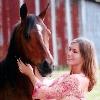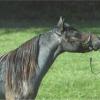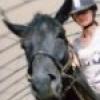My 1943 book of horses says....
Forums
Re: My 1943 book of horses says....
Old King - that is a line and it's own breed mentioned by the DW studies, but they have not been able to study one of those specimens yet.
I wonder if it always, without fail produces all white horses? You would think so from reading about them, but I wonder if there are ones swept under the rug....??
Re: My 1943 book of horses says....
Was responding to Krickett-
No dark spots appeared on his skin, which was of the necessary pink colour, and his hair was snow-white and silky, both mane and tail being very full.
It doesn't mention eye color.
.......
Foals are usually true Palomino at birth, with blue eyes. The colour chnages somewhat with age, and the eyes darken. Manes and tails start by being chestnut, but whiten with age.
The majority (that it is describing) would be Palomino's considering Champagne is not at all that common today, Let alone back then- but yeah- Golds and Gold Creams (as well as others)would have been mistakenly called Palomino as some still are today.
Re: My 1943 book of horses says....
I have that book, it was edited by Reggie Summerhays, a legendary judge/horseman and a true gentleman in every sense of the word.
He wrote what was to become one of my "bibles" " The Elements of Riding" and he used to ride out in Hyde Park, in Rotten Row, on his Arab stallion Jaleel.
Jaleel was a dark liver chestnut and he was used by Alex Korda in the film "The Thief of Baghdad" as a flying horse (magical).
Alex Korda called him hos "Chocolate Horse" and he was famous on the set for his impeccable manners. This film and others (The Black Orchid) were shot just up the road from me at Denham Studios, the remnants of which are still there. The last film to be shot there was Chitty Chitty Bang Bang.
I have always thought Old King was DW....the other famous white horse was, of course, Silver, who was also white with dark eyes, not sure that it was a stallion though, and, since it was in B&W I am not certain it has pink genitalia.
In the remake film there were a number of Silvers (the original TV series had just the one, maybe plus a stand in) and they ranged from smallish, main animal, I think maybe Morgan??? who had dark blue eyes and pink skin and genitalia, then a couple of the stand ins had dark skin and one was a Fewspot!!! (and it showed, too).
Re: My 1943 book of horses says....
I had this from a 1963 book of my mothers:
"Scientists are inclined to believe that Palominos contain a dilution factor in their genetic make-up which tens to dissolve their color when they are mate. Breeders agree that "golden horses" com chiefly from three matings: Palomino to sorrel (this produces the highest percentage - 50 percent); Palomino to Palomino; and albino to chestnut or sorrel.
The Palomino seems to be a close relative of the albino, for when two Palominos are bred together it is not unusual for them to produce an albino with its white eyes, pink-white skin and white feet."
Re: My 1943 book of horses says....
[quote="narmowen"]I had this from a 1963 book of my mothers:
"Breeders agree that "golden horses" com chiefly from three matings: Palomino to sorrel (this produces the highest percentage - 50 percent); Palomino to Palomino; and albino to chestnut or sorrel."[/quote]
Huh? Why would the highest percentage not be "albino to chestnut"?





Re: My 1943 book of horses says....
If i have time later I'll tell about the Pinto breed, which only mentions two patterns "Tobiano and Overo"